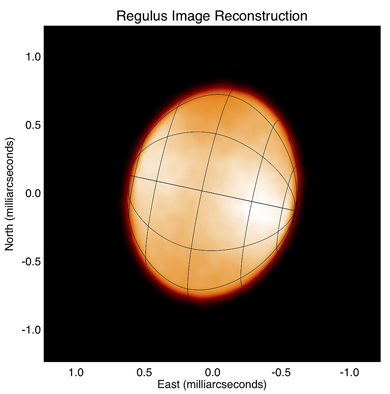- Date
- May 11, 2011
- Written By
-
Nicole Casal Moore

The hottest stars in the universe spin so fast that they get a bit squished at their poles and dimmer around their middle. A 90-year-old theory predicts the extent of this “gravity darkening” phenomenon—but that theory has major flaws, according to a new study led by University of Michigan astronomers.

An image of the star Regulus, which University of Michigan astronomers and their colleagues were able to ‘zoom in’ on using a technique called interferometry. Zooming in allowed them to measure the temperature of the star’s poles separately from its equator, which enabled them to find flaws in a century-old astronomical theory about hot, fast-spinning stars. (Image: Xiao Che.)
The von Zeipel law, named for its creator, Swedish astronomer Edvard Hugo von Zeipel, has been used for the better part of a century to predict the difference in surface gravity, brightness and temperature between a rapidly rotating star’s poles and its equator.Using a technique called interferometry the researchers essentially zoomed in to take close-up pictures and measurements of the winter star Regulus. It’s the brightest star in the constellation Leonis and if it were spinning just a few percent faster, it would fly apart.The astronomers found that the actual difference in temperature between its equator and poles is much less than the old theory predicts.”Our model fitting of interferometry data shows that while the law correctly describes the trend of surface temperature variation, it deviates quantitively,” said Xiao Che, a doctoral student in the Department of Astronomy who is first author of a paper on the findings, published in Astrophysical Journal on April 20.”It is surprising to me that von Zeipel’s law has been adopted in astronomy for such a long time with so little solid observational evidence.”It’s important to get this number right, says John Monnier, an associate professor in the U-M Department of Astronomy.”In some cases, we found a 5,000-degree Fahrenheit difference between what the theory predicts and what our actual measurements show,” Monnier said. “That has a big effect on total luminosity. If we don’t take this into account, we get the star’s mass and age and total energy output wrong.”Monnier led the creation of the Michigan Infra-Red Combiner (MIRC) instrument that was used to take the measurements that led to this discovery. MIRC uses interferometry to combine the light entering four telescopes at the CHARA array at Georgia State University so that it seems to be coming through a device 100 times larger than the Hubble Space Telescope. The technique lets astronomers see the shape and surface characteristics of stars. Previously, stars were mere points of light even with the largest telescopes.In this case, zooming in on Regulus let the researchers measure its poles and equator temperatures separately.”Normally, you would just be able to get an average temperature,” Monnier said.So where did von Zeipel go wrong? Monnier believes his Swedish predecessor didn’t take into account circulation on stars that’s not unlike wind patterns on Earth.”The Earth has a hot equator and cold poles and that causes air circulation,” Monnier said. “The hot air wants to flow toward the poles and equilibrate, bringing the temperatures closer together. This is a source of some weather patterns on Earth.”The paper is titled “Colder and Hotter: Interferometric imaging of β Cassiopeiae and α Leonis.” The CHARA Array is funded by the National Science Foundation and Georgia State University. Funding for the MIRC combiner came from the University of Michigan and observations were supported through National Science Foundation and NASA.




